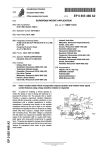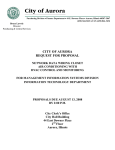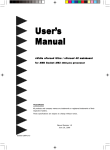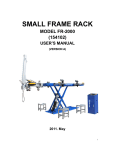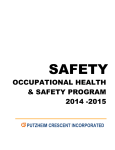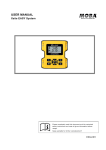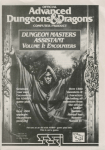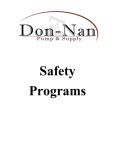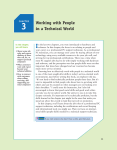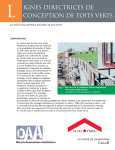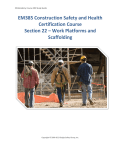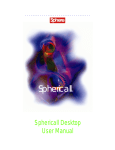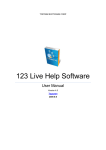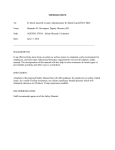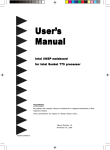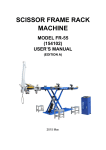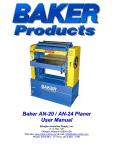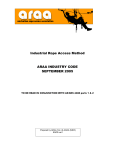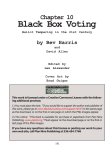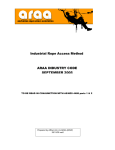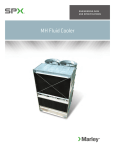Download CPI Safety Manual - Construction Partners
Transcript
CONSTRUCTION PARTNERS, IN C. SAFETY PROGRAM AND GENERAL RULES CONSTRUCTION PARTNERS, INC. SAFETY PROGRAM AND GENERAL RULES INTRODUCTION This manual is issued to inform subcontractors and their employees, as well as employees of Construction Partners, Inc., about the policies that are the basis for the Safety Program of Construction Partners, Inc. Every person is expected to become aware of the contents of this manual and to concern himself or herself with his or her own safety, the safety of fellow workers, and the safety of the general public. This entails willing acceptance and active support of these safety policies, rules and procedures. This manual will be available on our website www.cpichicago.com as a link and should be reviewed periodically for updates. This manual will not and cannot identify and cover every task performed and encountered by the individual on a daily basis, but is an attempt to provide a guideline, along with common sense, for a safe jobsite. It is imperative that one be constantly on the alert for potential hazards which are not referred to in any written practices, but which may result in injuries or property damage. Proper planning can control accidents. Continual emphasis on safety techniques, the refinement of work procedures, and safe working conditions has shown to significantly reduce injuries and property damage, and increase efficiency. We want to stress the importance of proper attire on a job site. This is important not only for the purpose of appearance, but more importantly for safety. Remember, no one will be allowed to work on any job without wearing safety glasses with side shields, hard hat, if required, and work boots – no gym shoes or sandals are allowed. If you show up at a job without the required attire, you will not be allowed to work and asked to leave. Also, we would like to note that LISTENING is an activity we often take for granted, sometimes with costly consequences. As many as two-thirds of all jobsite errors are related to poor communications. And these errors can cause delays, cost overruns, even accidents and injuries. Make the effort to be an active listener. Make sure you understand the message. Repeat its key elements back to the other person to make sure you both understand. Good communication is as much a productivity-enhancer as any tool on the job. Protect yourself and others from accidents and needless health hazards by following safety rules and common sense safety practices at all time – on and off the job. Revised June 2015 Page 1 of 31 CONSTRUCTION PARTNERS, IN C. SAFETY PROGRAM AND GENERAL RULES TABLE OF CONTENTS PAGE 1: PAGE 2: PAGE 3: PAGE PAGE PAGE PAGE 4: 5: 6: 8: PAGE 10: PAGE 11: PAGE 12: PAGE 13: PAGE 14: PAGE 15: PAGE 16: PAGE 17: PAGE PAGE PAGE PAGE PAGE 18: 19: 20: 21: 22: PAGE 23: PAGE 24: PAGE PAGE PAGE PAGE 25: 25: 27: 28: INTRODUCTION Table of Contents A. Staying Alert B. Basic Safety Practices C. Clothing and Equipment D. Personal Protective Equipment (PPE) E. Fall Protection F. Silica G. Ladders H. Scaffolds I. Physical Readiness J. Unauthorized Actions on the J ob K. Housekeeping L. Hazard Communications M. Inj uries/Incidents N. First Aid O. Exposure Plan P. Emergency Action Plan Q. Fire Warnings R. Welding S. Combustibles T. Confined Space Work U. Loads & Lifting – Back Inj ury Prevention V. Tools & Equipment W. Vehicle Safety X. Excavations & Trenching Y. Underground Utilities Z. Heavy Equipment AA. Forklift/Powered Industrial Trucks BB. Cranes & Rigging CC. Electrical DD. Procedures EE. OSHA, Agency & Code Compliance FF. Short Service Employee (SSE) GG. Subcontractor Management HH. Process Safety Management II. Insurance JJ. Not an Employee Note to All Subcontractors Revised June 2015 Page 2 of 31 CONSTRUCTION PARTNERS, IN C. SAFETY PROGRAM AND GENERAL RULES PAGE 29 & 30: Acknowledgment of Safety Program Revised June 2015 Page 3 of 31 CONSTRUCTION PARTNERS, IN C. SAFETY PROGRAM AND GENERAL RULES A. STAYING ALERT 1. Help prevent accidents and inj uries before they occur. Watch for situations that may cause or lead to accidents and inj uries to yourself and/or others on the j ob. 2. Inform your supervisor before work proceeds if you have a question pertaining to any operation of work where an inj ury could result. 3. Report all unsafe conditions, tools, equipment and practices to your supervisor or proj ect manager. 4. Remember that safe practices are primarily common sense and always make good sense. 5. Rushing, cutting corners and ignoring safety procedures and precautions to save time, save a few dollars or out of laziness leads to accidents. B. BASIC SAFETY PRACTICES (Also see PPE below) 1. Maintain good housekeeping at all times in all areas. 2. Keep materials orderly. 3. Clean up oil, grease and water spills immediately to prevent slipping. 4. Keep loose materials off stairs, walkways, ramps, platforms, etc. 5. Make sure there is safe access to work areas. 6. Read danger warnings on container labels, and follow any health/safety precaution. 7. Remove nails in old lumber. 8. Do not block aisles or traffic lanes for fire exits. 9. Avoid shortcuts. Use ramps, stairs, walkways, ladders, etc. 10. When entering different work areas, find out what safety precautions are required. 11. Be sure of your footing and surroundings. Watch out for overhanging or broken planks, slippery spots, loose obj ects, etc. 12. Use a safety harness and proper tie off if other fall protection is not available. 13. Place barricades and signs to warn of overhead danger, traffic, excavation, etc. Have warning lights, flagman or watchman if necessary or required. 14. Store equipment, tools and materials sufficiently far enough from the edge of an excavation to prevent them from falling. 15. Do not throw tools into or out of trenches, from roofs, off scaffolds, etc. 16. Read material safety data sheets (MSDS) about safe use, storage and clean up of specified materials. 17. Wear all necessary personal protective equipment (PPE). 18. Know and review safety procedures prior to the start of each day’s work. Revised June 2015 Page 4 of 31 CONSTRUCTION PARTNERS, IN C. SAFETY PROGRAM AND GENERAL RULES 19. J ust because “this is the way we’ve always done it” has worked in the past, doesn’t mean it’s correct or safe. 20. Food and beverages should only be consumed in designated areas. 21. Do not cross barricades, remove lockout/tag out devices or ignore “Danger” markings. 22. Obtain special work permits for Confined Space Entry, Lockout/Tag-out, Hot Work or Line Breaking. C. CLOTHING AND EQUIPMENT (Also see PPE below) 1. Wear clothing suitable for the weather and your work. 2. Wear boots in good condition and suitable for your trade. Additional protection may be required for certain tasks, such as rubber boots when working in concrete. NO GYM SHOES OR OPEN TOE, OPEN HEEL OR HIGH HEEL (greater than 1”) SANDALS. See PPE below. 3. DO NOT wear torn, ragged or loose fitting clothing while operating drills, pipe machines or other types of equipment with exposed moving parts. 4. WEAR A HARD HAT in areas when there is a possible danger of exposure to falling or flying obj ects, burns, electrical shocks, low clearances or proj ections. 5. Eye protection is mandatory on all j obs. SAFETY GLASSES WITH SIDE SHIELDS meeting ANSI Z87 are the minimum accepted protection. Additional protection may be required for a given task. See PPE below. 6. Wear a safety vest when you will be subj ect to traffic hazards such as on or near a roadway, aisle or railroad tracks. 7. Use gloves, aprons or other suitable skin protection when handling rough materials, chemicals or hot or cold obj ects. 8. Replace protective apparel and PPE if worn out, defective, damaged or obsolete. 9. All required personal protective equipment is to be supplied by the subcontractor and must be used in the designated manner. CPI does not provide protective equipment to subcontractors. Protective equipment, including personal protective equipment for eyes, face, head, and extremities, protective clothing, respiratory devices, and protective shields and barriers, shall be provided, used, and maintained in a sanitary and reliable condition wherever it is necessary by reason of hazards of processes or environment, chemical hazards, radiological hazards, or mechanical irritants encountered in a manner capable of causing inj ury or impairment in the function of any part of the body through absorption, inhalation or physical contact 10. Employee-owned equipment. Where employees provide their own protective equipment, the employer shall be responsible to assure its adequacy, including proper maintenance, and sanitation of such equipment. Revised June 2015 Page 5 of 31 CONSTRUCTION PARTNERS, IN C. SAFETY PROGRAM AND GENERAL RULES D. PERSONAL PROTECTIVE EQUIPMENT (PPE) 1. All workers shall complete PPE training. Training should be documented and a copy of such provided to CPI. Each such employee shall be trained to know at least the following: a. When PPE is necessary; b. What PPE is necessary; c. How to properly don, doff, adj ust, and wear PPE; d. The limitations of the PPE; and, e. The proper care, maintenance, useful life and disposal of the PPE. 2. All workplaces need to be assessed to determine if hazards are present, or are likely to be present, which necessitate the use of personal protective equipment (PPE). If such hazards are present, or likely to be present, the following need to be done: a. Complete a written hazard assessment form daily. b. Select, and have each affected employee use, the types of PPE that will protect the affected employee from the hazards identified in the hazard assessment; c. Communicate selection decisions to each affected employee; d. Select PPE that properly fits each affected employee. Respirators Respirators will be used when an employee is exposed to airborne hazards i.e. mold, silica, drywall dust, vapors, etc. Subcontractors are required to follow the respirator standards outlined by OSHA. See “SILICA” below. Face Shields Face shields must be worn when additional protection is needed for activities such as grinding, chipping, buffing, working with chemicals or when the potential exists to come in contact with blood borne pathogens or any other bodily fluid, generally where hazards to the face exist. Face shield shall not be altered in any fashion reducing the protective area provided by cutting the size of the face shield down. Hearing Protection Hearing protection must be worn in areas identified as high noise areas. A high noise area is one that has noise levels above 90 decibels. If you need to raise your voice to speak to someone three feet away, you should be using hearing protection. Foot Protection Leather work boots must be worn at all times on the j ob site. Approved steel toe or safety toe boots and metatarsal guards are required when using j ack hammers, setting steel beams, etc. Revised June 2015 Page 6 of 31 CONSTRUCTION PARTNERS, IN C. SAFETY PROGRAM AND GENERAL RULES Hand Protection Appropriate gloves are required during certain work activities and should match the potential hazard. Exceptions to this policy are when gloves would pose a greater hazard or an unsafe condition. Certain chemicals or j ob site conditions may require the use of impermeable gloves. Vibratory tools may call for specialized hand protection. Fall Protection See below. 3. When workplace changes occur that require changes in PPE or the training, or when employee/sub demonstrate lack of use, improper use, or insufficient skill or understanding, PPE and training will be addressed and adj usted as needed. E. FALL PROTECTION Fall Protection requires those who work on or near the following to use an appropriate fall-protection system – generally, guardrail systems, safety-net systems, or personal fall-arrest systems – if they are at or above 6 feet. This applies to: Unprotected sides and edges Leading edges Walking and working surfaces where leading edges are under construction Hoist areas Holes in walking and working surfaces Form work and reinforcing steel Ramps, runways, and other walkways Excavations Dangerous equipment Overhead bricklaying and related work Low-slope and steep roofs Pre-cast concrete erection o Guardrail Systems Guardrail systems and their use shall comply with the following provisions: • Top edge height of top rails shall be 42 inches (plus or minus 3 inches) above the walking/working level. Midrails, when used shall be installed at a height midway between the top rail and walking/working level. Screens and mesh, when used, shall extend from the top rail to the walking/working level along the entire opening between the top rail supports. • Guardrail systems shall be capable of withstanding, without failure, a force of at least 200 pounds, in any outward or downward direction. • When guardrail systems are used at hoisting areas, a chain, gate or removable guardrail section shall be placed across the opening between the guardrail sections when hoisting operations are not taking place. Employees Revised June 2015 Page 7 of 31 CONSTRUCTION PARTNERS, IN C. SAFETY PROGRAM AND GENERAL RULES exposed to this type of work shall be tied off in a full body harness and either retracting lanyard or fixed length lanyard to secure anchor point which will not allow them to step off the edge. • o Cable guardrails require high visibility flagging every 6 feet and cannot deflect below 39 inches when loaded with 200 pounds. Personal Fall Arrest Systems J ob sites will only permit the use of full body harnesses and shock absorbing lanyards with double locking type snaphooks. o • The attachment point of the body harness “D” ring shall be located in the center of the wearer’s back near the shoulder level. The anchorage point shall be located at shoulder height or above the wearer’s head. • All straps and belts on the device are to be snug and secured to ensure proper performance of the equipment in the event of a fall. Personal fall arrest systems shall be inspected prior to each use of wear, damaged and other deterioration, and defective components shall be removed from service. • Lanyards, harnesses and components shall be used only for employee’s protection (as part of a personal fall arrest system or positioning device system) and not to hoist materials. Personal fall arrest systems and components subj ected to impact loading shall be immediately removed from service. They shall not be used again for fall protection until inspected and determined by a competent person to be undamaged and suitable for reuse • Personal fall arrests are typically designed for use by an employee having a combined person and tool weight of less than 310 pounds. If the employee and tool weight is greater than 310 pounds a competent person shall reevaluate the employee’s need to perform elevated work. Anchorage Points • Anchorage points shall be located directly above the work area to reduce the possibility of a swing fall. If work requires the employee to move horizontally then the anchorage point must move, or the employee may have to select a new anchorage above the work area. Fall distance must be minimized when selecting an anchorage point: a free fall must not exceed 6 feet. • All elevations at or above 6 feet must have a 100% fall protection system. This includes but is not limited to leading edge work, iron connecting, working off of Revised June 2015 Page 8 of 31 CONSTRUCTION PARTNERS, IN C. SAFETY PROGRAM AND GENERAL RULES elevated work platforms (scaffolding), boom type lifts, and residential type construction. Only full-body harnesses with shock absorbing lanyards and secure anchorage point may be used for personal fall arrest systems. If “safety monitors” or “controlled access zones” are to be used a fall protection plan must be submitted outlining controls, etc. F. SILICA All contractors and individuals on the j ob site are responsible for establishing their own program to address silica hazards. When workers inhale particles of crystalline silica, the smaller particles can become deposited in the lower lungs. Crystalline silica has a toxic effect that leads to the development of fibrotic nodules and scarring around the deposited silica particle. This fibrotic condition of the lungs is called silicosis. Route of Exposure in Construction • Chipping, hammering, drilling, sawing, or grinding rock concrete or brick. • Crushing, loading, hauling and dumping of rock and concrete. • Abrasive blasting using an abrasive containing silica or sand. • Sawing, hammering, drilling, grinding and chipping of concrete or masonry. • Demolition or concrete, brick, and masonry structures. • Sweeping floors where sawing, chipping, hammering, drilling, or grinding of concrete, brick, and masonry has been performed. Preventing Exposure • Install a water hose to wet down the dust at the point of generation. • Use concrete/masonry saws that provide water to the blade. • Recognize when silica dust may be generated and plan ahead to eliminate or control the dust at the source. Awareness and planning are keys to the prevention of silicosis. • Use engineering controls and containment methods to control the hazard and protect adj acent workers from exposures (e.g. local exhaust ventilation, wet methods, blast-cleaning machines and cabinets, etc.). • If engineering controls cannot be used personal protective should be provided and worn such as disposable dust masks, half mask dual cartridge respirators, fresh air supplied hood respirators, etc. G. LADDERS (Also see PPE and FALL PROTECTION) 1. ALWAYS inspect ladders before you use them. Any that are weak, damaged, have missing rungs, or appear unstable should be removed from the site, tagged as defective, and then destroyed. Revised June 2015 Page 9 of 31 CONSTRUCTION PARTNERS, IN C. SAFETY PROGRAM AND GENERAL RULES 2. Look out for overhead power lines before you lift, carry, or set up any ladder. Also when carrying a ladder, make sure your path is well lit and clear of scrap, tools, hoses or any obstacles that could trip you. 3. NEVER ever use metal (aluminum) ladders near overhead power lines or in any other places where you can come in contact with energized electrical equipment or circuits. 4. Set ladders on a firm level surface – never on boxes, tables, carts, ice or other unstable surfaces. If the base is soft, uncompacted or rough soil, use a firmly anchored mudsill. 5. Do not place ladders against flexible or movable surfaces. Do not place a ladder against a sash or window. NEVER place a ladder in front of a door that opens toward the ladder. 6. Secure both the bottom and top of the ladder to prevent accidental movement. 7. Never overload a ladder. Limit single-width ladders to one person at a time. On a double-width ladder, a maximum of two people should be allowed only when each is on a separate side. 8. The ladder should be long enough so you can stand NO HIGHER than the fourth rung from the top and do not have to extend yourself precariously in order to reach for any obj ect. 9. Always face the ladder when climbing up or down or working from it. Maintain three-point contact (two hands and one foot, or two feet and one hand) when climbing up or down a ladder. Keep your body between the rails; don’t lean to either side. NEVER straddle the space between the ladder and another point. Make sure your footwear has slip-resistant soles and heels. 10. Never use ladders in a horizontal position as runways or scaffolds. Nearly half of all ladder accidents occur when the ladder is used as a work platform rather than for access. 11. Always use ladders in trenches with a depth of four feet or more. 12. Use hand lines or material hoist to lift loads. Do not lift electrical tools by cord. 13. ALWAYS use the appropriate fall-arrest equipment, such as safety harnesses and lifelines. 14. Each step or rung shall be capable of supporting a single concentrated load of at least 250 pounds, be uniformly spaced and meet OSHA/ANSI standards. 15. Non-conductive, type I, portable, fiberglass ladders are recommended for use on the j ob site. These ladders shall be equipped with safety shoes, spikes or spurs and shall have flat top rungs. 16. Use only the proper type of ladder, matched to the j ob or task, according to the manufacturer’s instructions. 17. Make sure hands, shoes, and ladder rungs are free of oil, grease, mud or other material before climbing. Revised June 2015 Page 10 of 31 CONSTRUCTION PARTNERS, IN C. SAFETY PROGRAM AND GENERAL RULES 18. All ladders must be regularly inspected by a competent person to ensure their safe working condition. 19. Ladders placed in any location where they can be displaced by workplace activities or traffic, such as in passageways, doorways, or driveways shall be secured to prevent accidental displacement or a barricade shall be used to keep the activities or traffic away from the ladder. 20. A ladder must extend 3 feet above the upper level when used for access to an upper elevation. 21. Ladders shall be used at an angle such that the horizontal distance from the top support to the foot of the ladders is approximately one-quarter, or 4-1 of the working length of the ladder. Fall protection may be required for certain types of work for extended periods while working from ladders. Ladder use in areas exposed to dangerous falls, building edges, open stairways, etc. call for fall protection or adj usting the work, i.e., replacement with completed scaffolding or a lift. See PPE & FALL PROTECTION. H. SCAFFOLDS (Also see PPE and FALL PROTECTION) Scaffolds must be erected, moved, dismantled, or altered only under the supervision of a competent person. The competent person must be on the work site to direct and supervise all scaffold erecting, dismantling, altering, and moving operations. Work must be performed only by trained, experienced persons selected by the competent person. 1. Use a scaffold if solid footing or safe ladder access is not possible. 2. Scaffold should have adequate bracing, footing, access ladder and safety rails, plus proper planking and platforms and conform to applicable OSHA safety standards. 3. Platform planks should overlap supports not less than 6” nor more than 12” and be secured from shifting. 4. Keep all tools and materials away from edges of scaffolds, platforms, shaft opening, etc., and barricades should be provided under any elevated work site. 5. Working on a scaffold is prohibited during storms or high winds. 6. Scaffolds must be able to support their own weight and at least four times the maximum intended load applied to them. (The intended load includes workers, equipment, and material loads. The intended load should never exceed the rated load.) 7. The front edge of a scaffold platform cannot be more than 14 inches from the face of the structure unless guardrails or personal fall arrest systems are used to protect workers from falling between the structure and the platform. 8. Wood platforms cannot be covered with coatings or paint finishes, because finishes cover defects in wood. Revised June 2015 Page 11 of 31 CONSTRUCTION PARTNERS, IN C. SAFETY PROGRAM AND GENERAL RULES 9. Each platform (working or walking) on all levels of the scaffold shall be fully planked or decked between the front upright and the guardrail supports. 10. Each end of a platform, unless cleated or otherwise restrained by hooks or equivalent means, shall extend over the centerline of its support at least 6 inches. 11. Each end of a platform 10 feet or less in length shall not extend over its support more than 12 inches unless the platform is designed and installed so that the cantilevered portion of the platform of the platform is able to support employees and/or materials without tipping, or has guardrails which block employee’s access to the cantilevered end. 12. Each platform greater than 10 feet in length shall not extend over its end support more than 18 inches, unless it is designed and installed so that the cantilevered portion of the platform is able to support employees and/or materials without tipping, or has guardrails which block employees access to the cantilevered end. 13. On scaffold where platforms are overlapped to create a long platform, the overlap shall occur only over supports, and shall not be less than 12 inches unless the platforms are nailed together or otherwise restrained to prevent movement. 14. Workers must be provided with safe access to scaffolds and scaffold platforms. Ladders must be attached or secured to the scaffold and extend 3 feet past the platform. Do not use cross braces as a means of access. 15. Along with protecting workers from falling obj ects above and below scaffolding, workers on scaffolding more than 10 feet above a lower level must use fall protection at all times (guardrails, personal fall arrest system, etc.). 16. Supported (including braces, or materials, workers. scaffolds with a height-to-base width ratio of more than 4 to 1 outrigger supports) must be restrained from tipping by ties, equivalent means. “Equivalent means” refers to other designs, or methods that provide an equal or greater degree of safety for 17. Poles, legs, posts, frames, and uprights must bear on base plates and mudsills or a firm foundation. The scaffold structure must be plump and braced so that it does not sway. 18. Scaffold components manufactured by different manufacturers shall not be intermixed unless the components fit together without force and the scaffold’s structural integrity is maintained by the user. I. PHYSICAL READINESS 1. Report to work rested and physically fit to perform your j ob. 2. Keep your mind on your j ob and your temper under control! 3. Give your wholehearted support to safety activities. 4. Do not wear j ewelry (rings, bracelets, neck chains, etc.) while working. Revised June 2015 Page 12 of 31 CONSTRUCTION PARTNERS, IN C. SAFETY PROGRAM AND GENERAL RULES J. UNAUTHORIZED ACTIONS ON THE JOB. 1. Any person who reports for work while under the influence of alcohol or controlled substances will not be permitted to work. 2. Horseplay, rough housing, practical j okes, or any similar activity is prohibited. 3. CPI employees and subcontractor employees must confine their activities to areas designated by the customer and follow customer’s rules for restricted activities in conj unction with this list. 4. Unauthorized use of customer material and/or equipment is prohibited. 5. Yelling, throwing tools or other potentially dangerous acts out of anxiety, frustration, or anger are prohibited. 6. Misuse of tools and equipment, not following safety procedures, failure or refusal to wear PPE, failure to comply or disregard of previous notice of unauthorized action. 7. Proj ect manager shall perform routine inspections of work areas to ensure compliance with safety rules and address any actions deemed unsafe or inappropriate with employee performing such activity. Said employee shall be informed of the rules or procedures violated and instructed on the proper course of action. 8. CPI employees and subcontractor employees must respect the confidentiality of trade secret information. Process, procedures and equipment may be unique to the customer so photographs and descriptions should be approved prior, during, and after estimates, progress of work and completion of proj ect. K. HOUSEKEEPING Good housekeeping prevents accidents. Poor housekeeping causes accidents. It is the responsibility of every worker on the j ob site to keep their work area neat, clean and organized. Never rely on others to maintain your work area. Good housekeeping is especially critical in the following areas: Aisles, passageways, stairs, floor perimeters, exits, and storage access-ways. 1. Keep tools and working materials in proper containers. 2. Store materials safely and properly. 3. Smoke in designed areas, away from flammables and put cigarette stubs in butt cans. 4. Keep floor clear of tools, metal shavings, pipe, wood scrap, sawdust, etc. 5. Keep walkways clear. Aisle ways must have at least a 22” wide clearance. 6. Clean up tools and work areas as your j ob progresses. Keep small trash cans available at your work area. Revised June 2015 Page 13 of 31 CONSTRUCTION PARTNERS, IN C. SAFETY PROGRAM AND GENERAL RULES 7. Keep cords and hoses seven feet overhead or lay them flat outside the walkways. 8. Keep stairways and ladder access ways clear of debris, cords, and materials. 9. Clean up spills or leaks right away. If a leak appears, find the source. 10. Visqueen curtains and enclosures, vacuum tool attachments, exhaust scrubbers and filters are j ust some of the methods that should be employed to reduce or minimize dust and dirt created on a j ob. 11. Keep visqueen and other materials that may blow away from elevated locations secured. Visqueen has no place in walkways or access ways. 12. Prior to work commencement, each contractor on the j ob site shall determine the amount of waste to be potentially generated and will be responsible to control and remove any materials or debris created by the work performed by their employees. 13. Waste and scrap materials shall be properly stored to minimize potential for spill or impact to the environment. 14. Subcontractors will be subj ect to a back-charge if someone else is required to clean up a work site to the customer’s satisfaction. 15. Employees shall be instructed on proper disposal of wastes. 16. All trash, non-hazardous waste and scrap (such as pipe, wood, oily rags, broken glass, lunch debris, aerosol cans, etc.) must be placed in properly identified and correct containers. 17. Employees shall be trained in the proper disposal of hazardous materials. 18. Be sure to properly separate waste to reuse and recycle whenever possible. L. HAZARD COMMUNICATIONS 1. CPI will make efforts to discuss possible hazards with the customer(s) prior to start of the work to determine and identify if hazards exist, take necessary precautions as related to those identified hazards (such as face shields, SDS sheets, etc.) and communicate same. 2. A written hazard program will available at each j obsite with chemical list, SDS information, and other pertinent information. 3. Any known hazards shall be discussed prior to the start of each proj ect and an ongoing list of all chemicals shall be posted at j obsite and updated as needed. 4. CPI employees will be provided information and training on hazardous chemicals in their work area at the time of their initial assignment and as a new physical or health hazard is introduced into their work area. This includes instruction on reading all labels for directions and potential hazardous conditions, PPE requirements, safety and first aid training as well familiarity with HCS pictograms and hazards. 5. All containers shall be labeled properly with product identifier and words, pictures, symbols or combination thereof, which provide information Revised June 2015 Page 14 of 31 CONSTRUCTION PARTNERS, IN C. SAFETY PROGRAM AND GENERAL RULES regarding the hazards of chemicals as well as contact information for the chemical manufacturer, importer or responsible party. 6. SDS sheets will be provided with each j ob sheet and subcontractor PO when applicable, and once reviewed, placed in the SDS binders of the CPI vehicles for future reference and made available at each j ob site. 7. SDS sheets will also be provided to customers when any chemicals or other hazardous materials are being used in conj unction with work to be performed by CPI or its subcontractors. M. INJURIES/INCIDENTS 1. Be sure that immediate action is taken to furnish proper treatment for all inj uries, including calling 911 if necessary. 2. Report all inj uries, no matter how slight, safety related incidents and near misses that arise to your supervisor immediately. 3. An accident/incident report should be prepared for all inj uries, identifying person involved and complete description of occurrence and what measures have been taken to prevent recurrence, if appropriate. 4. CPI will then notify the owner’s accountable person immediately of work related inj uries, fires, chemical spills or environmental issues and shall submit a preliminary report regarding such incidents or accidents. 5. Inj uries, illnesses and fatalities must be entered on OSHA 300 Log and OSHA 301 Incident Report within 7 days of incident occurring. (see “OSHA” below) N. FIRST AID 1. A basic First Aid Kit must be furnished by the employer and readily accessible at a j ob site for inj uries such as minor cuts. First Aid Kits will also include contents relative to the environment in which they may be used. 2. Know the location of the First Aid Kit and proper use of its contents. 3. Report to your supervisor if the First Aid Kit is missing, or if any of the materials are out of stock. First Aid Kits shall be checked weekly to ensure the availability of adequate supplies. 4. On j ob sites or in areas in which persons may be exposed to inj urious corrosive materials CPI shall obtain from the owner’s accountable person the location and operating method of eyewash stations and /or safety showers for proper flushing of eyes or body. 5. A First Aid Kit is not a substitution or an excuse for obtaining more substantial and professional care and evaluation. 6. A person with valid certification in first aid shall be available to render care if medical assistance is not reasonably accessible by time or distance from the worksite. (Proper training and certification must be obtained from the American Red Cross or equivalent training, verified by documentary evidence.) Revised June 2015 Page 15 of 31 CONSTRUCTION PARTNERS, IN C. SAFETY PROGRAM AND GENERAL RULES 7. Each situation is unique and should be assessed prior to moving or treating inj ured party. Proper equipment shall be available for prompt transport or to contact necessary ambulance service for transport to the nearest hospital or medical facility O. EXPOSURE CONTROL PLAN (Also see PPE) 1. All employees utilize universal precautions. 2. Employees covered by the blood borne pathogen standard and who may be potentially exposed to blood or other potentially infectious materials shall receive explanation of this ECP during their initial training and it will also be reviewed in their annual refresher training. This plan is available for all employees to review at any time either by CPI website or this safety manual provided onsite or in company vehicles. 3. PPE is provided to our employees at no cost to them. Training in the use of the appropriate PPE for specific tasks or procedures is provided by the project manager. Records of such training shall be maintained for no less than three years. 4. All employees using PPE must observe the following precautions: a. Wash hands immediately or as soon as feasible after removing gloves or other PPE. If a hand washing station is not readily available, appropriate antiseptic hand cleanser and towels or antiseptic towelettes will be available for use. b. Remove PPE after it becomes contaminated and before leaving work area. c. Wear appropriate gloves when it is reasonably anticipated that there may be hand contact with blood or other potentially infectious material, and when handling or touching contaminated items, or surfaces; replace gloves if torn, punctured or contaminated, or if their ability to function as a barrier is compromised. d. Wear appropriate face and eye protection when splashes, sprays, spatters or droplets of blood or other potentially infectious materials pose a hazard to the eyes, nose, or mouth. e. All equipment or surfaces must be cleaned and decontaminated after contact with blood or other potentially infectious materials. 5. The Hepatitis B vaccination series is available at no cost to all employees with occupational exposure. 6. Due to HIPAA, we do not maintain employee medical records; however a copy of their employment records are maintained Revised June 2015 Page 16 of 31 CONSTRUCTION PARTNERS, IN C. SAFETY PROGRAM AND GENERAL RULES including any documented exposures. Such records shall be kept for the duration of employment plus 30 years. P. EMERGENCY ACTION PLAN 1. Make sure that hospital or nearest emergency medical facility, as well as fire and ambulance service telephone numbers are posted at each j ob site along with Owner’s security emergency number, if provided. 2. Maintain a list of emergency information for personnel working at site; including contact information for Proj ect Manager should employee have any questions regarding the Emergency Action Plan. 3. Each employee shall be made aware of the Emergency Action Plan including emergency exit locations, assembly areas, evacuation routes and the type of evacuation alarm system utilized in the facility. In the event of an emergency evacuation, employees are to follow the directions of the Emergency Response personnel and plant supervisors. A head count will take place after an evacuation. The identity and last known locations of anyone not accounted for will be collected and passed to the official in charge . 4. Employees will be instructed verbally and/or through review of this manual upon commencement of work and periodically as the plan is updated and developed to meet the needs of each j ob site. 5. If there is an emergency (fire, life threatening incident, etc.) call the Owner’s security emergency number, if provided. If no emergency number has been provided, call 911. Q. FIRE WARNINGS 1. “No Smoking” signs stand guard near fire dangers. ALWAYS. OBEY THEM … 2. Know locations and use of fire extinguishing equipment, as well as how to activate the fire alarm. 3. Clearly label all flammable liquid containers and make sure the containers are UL approved. 4. Store oily wiping rags in covered metal containers or dispose of them safely. 5. Keep a fire watch with adequate fire extinguishers during and after “hot work” as j ob location requires. R. WELDING 1. An approved welding helmet and appropriate clothing must be worn at all times during any welding or cutting process. 2. Closely supervise welding and cutting work, and be sure to remove or shield nearby combustibles. Revised June 2015 Page 17 of 31 CONSTRUCTION PARTNERS, IN C. SAFETY PROGRAM AND GENERAL RULES 3. Do not look at welding or cutting operations without wearing proper eye protection. 4. Proper welding curtains must be used to shield potential on-lookers from eye damage and to contain sparks, etc within a controlled area. 5. Check hoses, fittings and valves for leaks. Keep cylinders upright and secured. Any damaged or faulty equipment should be properly repaired or replaced. S. COMBUSTIBLES 1. Keep salamanders or other portable heating equipment away from combustible materials and make certain the area is properly ventilated. 2. Make sure engines in buildings are away from combustibles and exhaust is properly ventilated. 3. Shut off fuel powered equipment while re-fueling. 4. Store fuel in its proper and undamaged vessel and in a safe location. T. CONFINED SPACE WORK 1. Persons doing work in confined space areas should be trained for such work, including emergency circumstances, etc. 2. Proper safety equipment, such as respirator and harness, shall be provided by the sub-contractor doing the work. 3. A designated “watch” person must be present at all times. U. LOADS AND LIFTING - BACK INJURY PREVENTION Back strains and other related muscle strains account for more than half of all work related inj uries. Unfortunately, many workers learn the proper method to lift safely after an inj ury. If you still have concerns or questions regarding back and/or related inj ury prevention, check with your supervisor. Use material handling equipment as much as possible. This means preplanning and scheduling large equipment such as asking a co-worker to help you lift something versus lifting it by yourself. Plan your workstation to limit bending and twisting. Use saw horses and work tables as much as possible. Use pallet j acks and carts to move heavy and/or awkward items when feasible. To summarize, there are methods we can use that can reduce the chance of back and other related inj uries, increase productivity and save costs of the j ob. • Plan for the best use of material handling equipment. • Plan the j ob looking for items that could be pre-fabricated. • Have materials delivered as close as possible to the area of heaviest use. Revised June 2015 Page 18 of 31 CONSTRUCTION PARTNERS, IN C. SAFETY PROGRAM AND GENERAL RULES • Train employees the correct method to do the j ob. • Take a few minutes and stretch out before work and at other opportunities, such as periods of time spent waiting for materials or other workers (waiting for concrete, or other workers to catch up is opportune time to stretch). • For work processes that require repetitive motion or vibration, consider j ob rotation of employees. This may also aid in improvement of overall j ob skills and team building. • Regular exercise, eating nutritiously and drinking plenty of water will also help reduce muscle inj uries. Implement some of the following resources to help reduce inj uries: 1. A regular stretching routine. This should take no longer than five minutes a day and should be done by all personnel on a daily basis. 2. This basic rules for safe lifting: o Plan the lift. o Use a mechanical lifting aid if available. o Move close to the load. o Keep your back straight. o Bend with your knees and lift with your legs. o Do not lift and twist in the same motion. o If the load is too heavy, get help. V. TOOLS & EQUIPMENT All workers on the j ob site must be trained in the use of tools and equipment needed to perform their j ob. They should understand the potential hazards as well as the safety precautions required to prevent those hazards from occurring. General Saf ety 1. Never carry a tool by the cord or hose. 2. Never yank the cord or the hose to disconnect it from the receptacle. 3. Keep cords and hoses away from heat, oil, and sharp edges. 4. Disconnect tools when not in use, before servicing, and when changing accessories such as blades, bits and cutters. 5. Keep all observers at a safe distance away from the work area. 6. Secure work with clamps or a vise, freeing both hands to operate the tool. 7. Avoid accidental starting. The worker should not hold a finger on the switch button while carrying an energized tool. 8. Maintain all hand and power tools with care. They should be kept sharp and clean for the best performance. Follow instructions in the user’s manual for lubricating and changing accessories. Revised June 2015 Page 19 of 31 CONSTRUCTION PARTNERS, IN C. SAFETY PROGRAM AND GENERAL RULES 9. Be sure to keep good footing and maintain good balance. 10. Wear the proper apparel. Loose clothing, ties, or j ewelry can become caught in moving parts. 11. Remove all damaged portable electric tools from use. Tag them ‘DEFECTIVE TOOL” or “DO NOT USE” and return them for repair. 12. Report defective power tools, hand tools or machinery to supervisor. 13. All pneumatic tools, which shoot nails, rivets, or staples and that operate at pressure more than 100 pounds per square inch, shall have a device to keep fasteners from being ej ected unless the muzzle is pressed against the work surface. 14. All portable grinding tools shall have guards to protect workers not only from the moving wheel surface but also from flying fragments in case of breakage.NEVER use tools with split, broken or loose handles. 15. Use guards on all power tools. Guards shall not be manipulated in such a way that will compromise the integrity or protection intended and shall meet ANSI B15.1 requirements. 16. Have tools with burred and mushroomed heads dressed. tools sharp and carry in a container (not in your pocket). Keep cutting 17. Know correct use of hand tools before using, and use the right tool for the j ob. 18. Do not operate service power tools, vehicles and other machinery unless you are qualified to do so. 19. Wear appropriate safety equipment (i.e., goggles, ear plugs, respirators, etc.) 20. Do not use electrical power tools or equipment while standing in water. Keep cords out of puddles and away from any water source. 21. Take care to place cords, leads, hoses, etc. in a manner as to avoid tripping hazards or getting damaged. Keep them away from oil, heat and chemicals. 22. Have electrical equipment properly grounded. grounded receptacles and extension cords. Also, use 3-wire 23. Make sure cord splices or repairs are electrically/mechanically equal to that cord’s quality (no substandard patching). 24. All required power tools are to be the responsibility of the subcontractor and must be used in the designated manner. CPI does not provide power tools to subcontractors. 25. All tools and equipment brought onsite, owned or rented, shall conform to OSHA standards and be maintained in safe mechanical working condition. 26. When mobile equipment is not in use, it shall be secured to prevent movement, operation and toppling. This includes rented or leased. Revised June 2015 Page 20 of 31 CONSTRUCTION PARTNERS, IN C. SAFETY PROGRAM AND GENERAL RULES W. VEHICLE SAFETY 1. Always be seated when riding authorized vehicles (unless vehicle is designed for standing). 2. Do not ride in or on Endloader buckets, Backhoe buckets, etc., or any other equipment not specifically designed for that purpose. 3. Do not ride on vehicles or mobile equipment unless specifically authorized. Do not ride hook, ball rigging or load. 4. A safety harness must be worn when operating a boom lift. 5. Do not make phone calls or send texts, emails or other forms of electronic communication while operating a vehicle or equipment. 6. Ensure all materials, tools and other items are secure in the bed and on the rack of the vehicle before starting. 7. Lock any side boxes to prevent them from accidently opening while the vehicle is in motion and to prevent theft. 8. Always do a visual check of your vehicle and trailers for potential safety issues such as flat tires, tail lights burnt out, damaged safety chains, etc. X. EXCAVATIONS & TRENCHING A trained competent person shall be present at all times on the j ob site anytime excavation work is in progress or when site employees are working in an excavation. 1. A competent person must inspect excavations, adj acent areas and protective systems daily or after any occurrence, which could affect the stability of the excavation. 2. All j ob site employees working in excavations/trenches shall be protected against cave-ins, except when the excavation is in stable rock or less than five (5’) feet deep and examination by a competent person provides no evidence that a cave-in should be expected. 3. Expose direct buried cables by careful hand excavation prior to machine excavation. 4. Safe means of access/egress (stairway, ladder, ramp) for all trenches greater than 4 feet deep is required. 5. No one is allowed under the loads of digging equipment or equipment designed to lift or lower any item. 6. Excavating equipment must maintain at least 12 feet of clearance from any overhead-energized electrical power lines. 7. All j ob site employees exposed to public vehicular traffic are to wear high visibility warning vests. 8. Spoil piles, equipment, and materials must be placed at least 2 feet from the excavation edges. Revised June 2015 Page 21 of 31 CONSTRUCTION PARTNERS, IN C. SAFETY PROGRAM AND GENERAL RULES 9. A competent person must examine any excavation less than 5 feet to determine if there is any indication of a potential cave in and the need for protective system such as sloping or shoring. 10. All employees in excavations greater than 5 feet must be protected with either a sloping/benching/stepping system or a support system (trench box, shields, etc.). 11. Barricade or cover all excavations until backfilled. 12. Place excavation spoils far enough away to avoid load strain on walls and remove surface rocks that may fall in. 13. Do not permit vehicles too close to edge of cut. 14. Protect floor and wall openings according to OSHA standards. Y. UNDERGROUND UTILITIES 1. J ULIE (Joint Utility Locating Information for Excavators) is a free one-call system to locate and identify underground utilities in the State of Illinois (except the City of Chicago). Call: 1-800-892-0123. 2. Within the city limits of Chicago, call DIGGER: 1-312-744-7000. 3. Anytime you plan to dig, whether it’s a small or a large construction proj ect, you must call 48 hours (not counting weekends and/or holidays) prior to digging. 4. Be prepared to give the following information: a. Your telephone number, name, address, and fax. b. County and Township. c. Location of excavation site, which may include but not be limited to: address, cross street, lot numbers, etc.; also tier, range, section and quarter section numbers (if possible) of excavation site. d. The date and time work will begin. City or County and unincorporated area of 5. Make note of the dig number issued, as it identifies the specific location request record you had processed. This record contains all of the information about your call from start to finish along with the J ULIE members receiving the request. It is important that you write this number down and keep it with your records. J ULIE keeps this information on file for six years. 6. After the 48-hour advance notice and utilities have been marked, you may dig. However, you have an obligation to dig in a reasonable and prudent manner, taking all necessary and required measurements to avoid damaging underground facilities. 7. If, somehow, damage is done to an underground facility, immediately call the specific company involved using the emergency or repair number listed in the phone book. If in doubt as to whose facility it is, call J ULIE to inform the utilities in the area that a line has been Revised June 2015 Page 22 of 31 CONSTRUCTION PARTNERS, IN C. SAFETY PROGRAM AND GENERAL RULES damaged. Once the damaged line has been located, the excavator must call the utility to report the damage. 8. If you encounter labeled or colored concrete below grade, this is usually encasing electrical lines but any concrete below grade could act as an encasement. DO NOT attempt to break or remove this concrete. 9. Barricades and signs are to be installed around all openings. 10. Shoring requirements and confined space requirements are to be determined prior to any excavation. Z. HEAVY EQUIPMENT 1. Only properly trained and certified operators will be allowed to operate heavy equipment on the j ob site. The proj ect superintendent may require or verify documentation. 2. Operators are expected to know their equipment and its limitations. 3. Operators are expected to stay alert and use extreme caution while operating any heavy piece of machinery, especially when there are other workers in the area. 4. Operators are required to use the 3-point contact rule when mounting or dismounting equipment. 5. Before dismounting equipment, all implements are to be lowered to the ground and the brakes locked. 6. Riders are not allowed on equipment under any circumstances. 7. Heavy equipment must be equipped with backup alarms. 8. All equipment shall be equipped with a horn, distinguishable from surrounding noise levels. Horn should be used as a warning to others and when approaching blind corners or going down aisles or through door openings. AA. FORKLIFTS/POWERED INDUSTRIAL TRUCKS Only properly trained and certified operators will be allowed to operate forklifts or powered industrial trucks on the j ob site. The proj ect superintendent may require or verify documentation. 1. Never operate a forklift unless trained and authorized to do so. 2. Wear appropriate personal protective equipment when operating a forklift (hardhat, safety glasses, gloves, appropriate work boots). 3. Keep arms and legs inside the cab of the forklift at all times. 4. Inspect forklift daily and before each use. 5. Operate at a safe speed (at posted speed limits when applicable). 6. Do not exceed the rated capacity of the forklift. 7. Always drive a loaded forklift with the load on the uphill side. 8. Watch for overhead structures. Revised June 2015 Page 23 of 31 CONSTRUCTION PARTNERS, IN C. SAFETY PROGRAM AND GENERAL RULES 9. Never refuel with the engine running. 10. Never let a gasoline/propane/diesel idle in an enclosed area. 11. Watch for pedestrians. 12. Never allow any person to ride in or on the forklift. NO RIDERS! 13. Never leave a forklift running while unattended. considered to be 25 feet from the truck. Unattended is 14. Park the forklift carefully. Make sure the forks are on the ground, the breaks are set, the engine is off, and the keys removed. BB. CRANES AND RIGGING Only trained and qualified operators are allowed to operate cranes on the j ob site. 1. The swing radius of the rear of the rotating superstructure of the crane shall be barricaded in such a manner as to prevent all personnel from being struck or crushed. 2. Cranes shall be operated and maintained in good, serviceable and safe condition. No crane shall be used with cracked or defective components, which are in anyway unsafe to operate. 3. Hoisting a load over personnel is prohibited. 4 Tag lines must be used to control loads whenever practical and when their use does not create a hazard. 5. A critical-lift plan shall be prepared by the crane operator, lift supervisor, or rigging supervisor for all critical lifts. A critical lift is defined as a lift that exceeds 75% capacity of the crane, has unusual safety considerations, or involves hoisting a personnel basket. 6. Outriggers shall be fully extended when used and set to remove the machine weight from the wheels. If outriggers cannot be fully extended, the lift shall be made within the “on rubber” rating given on the crane’s load chart. 7. Adequate distance shall be maintained from all overhead exposed power lines. Chains Only chains specifically designed and tagged for lifting shall be used for such purposes. A chain shall be stamped with “A” or “#8” noting they are for lifting material. Wire Rope Sling Inspection Wire rope slings must be visually inspected for damage or defects before use including the sling, all fastenings and attachments. If ten randomly distributed wires in one lay are broken, or five wires in one strand of a rope lay are damaged, the sling is not to be used. Wire Rope Storage and Care Revised June 2015 Page 24 of 31 CONSTRUCTION PARTNERS, IN C. SAFETY PROGRAM AND GENERAL RULES Wire rope slings should be stored in a well-ventilated, dry building or shed. Wire rope slings must also be kept lubricated. Fiber Rope Fiber slings should be used only on light loads and must not be used on obj ects that have sharp edges capable of cutting the rope or in applications where the sling will be exposed to high temperatures, severe abrasion capacity. A synthetic web sling must be removed from service if any of the following defects exist: • Acid or caustic burns • Melting or charring of any part of the surface • Snags, punctures, tears or cuts • Broken or worn stitches • Wearing of elongation exceeding the amount recommended by the manufacturer • Distortion of fittings CC. ELECTRICAL DD. EE. 1. Make sure POWER IS TURNED OFF before servicing or installing electrical fixtures. Shut off at breaker or main disconnect and label or lock out for safety. 2. Lock out disconnects to overhead cranes. 3. Consider all wires “live” until checked and locked out. 4. Do not make electrical repairs or installations unless you are qualified to do so. Do not use metal ladders near high-powered electricity. PROCEDURES 1. Follow the rules of the company you are working at. If you do not, you will be asked to leave. 2. Have consideration for the people who work there. your areas clean. Keep noise down to a minimum. 3. Your actions and appearance directly reflect back to you, the company you work for, and Construction Partners, Inc. Make and leave a GOOD impression. Keep and leave OSHA, AGENCY & CODE COMPLIANCE 1. All subcontractors must comply with all state, local and public safety codes, laws, ordinances or regulations including, but not limited to the most current applicable regulations of the Occupational Safety and Health Act (OSHA 29 CFR 1910 & 1926) 2. Records shall be kept of all fatalities, inj uries and illnesses that are work related. OSHA 300 Log; OSHA 300A Summary; corresponding Revised June 2015 Page 25 of 31 CONSTRUCTION PARTNERS, IN C. SAFETY PROGRAM AND GENERAL RULES OSHA Form 301, if applicable; and privacy case list, if applicable, shall be retained for 5 years. 3. FF. The OSHA 300A summary shall be verified as complete and accurate by CPI’s president and/or vice president. Such summary shall be posted and made accessible to employees from February 1 s t through April 30 t h . SHORT SERVICE EMPLOYEES (SSE) 1. Prior to beginning work on site, CPI will notify the owner’s representative if there is a Short Service Employee on their crew. SSEs will not work alone and there will be no more than one SSE per crew of five or less. 2. SSEs will be uniquely identified, i.e., colored hard hat, etc., and such identification shall be communicated to the owner’s representative. 3. SSEs, those employees with less than six months in their current role, shall be mentored by an experienced/knowledgeable employee. Once they demonstrate competence with HSE, health and safety policies and procedures, the SSE identifier will be removed. 4. Subcontractors will be held to the same requirements regarding their crew. GG. SUBCONTRACTOR MANAGEMENT 1. All subcontractors are required to read and adhere to CPI’s safety procedures and are instructed to follow instructions at each job site particular to that customer. 2. Subcontractors will be included in pre-job meetings and are required to attend job safety meetings provided by CPI and/or the customer at the commencement of a project as well as throughout the project. 3. Each subcontractor shall perform frequent and regular safety inspections of their work area(s) by a competent person. Subcontractor supervisors shall take immediate action to correct violations, unsafe practices and unsafe conditions. 4. All subcontractors are required to submit their safety programs as well as any documents which support their safety metrics which include but are not limited to EMR, OSHA 300A summary, etc. Such documents will be used in part as pre-qualification for work. 5. Safety performance reviews will be conducted at the conclusion of the job. HH. PROCESS SAFETY MANAGEMENT (PSM) CPI adheres to a Process Safety Management plan in order to prevent or reduce the consequences of catastrophic release of toxic, reactive, flammable, or explosive chemicals in various work places and industries. Revised June 2015 Page 26 of 31 CONSTRUCTION PARTNERS, IN C. SAFETY PROGRAM AND GENERAL RULES 1. CPI shall inform its employees and subcontractors of the potential hazards of fire, explosion or toxic release, etc., as related to their job and instruct them in the work practices necessary to perform their work in a safe manner. Record of such training shall be maintained by CPI. All employees will also be made aware of the applicable provisions of the emergency plan. (See page 16 for Emergency Plan reference). 2. CPI employees and subcontractors shall follow safe work practices during all operations including lockout/tagout and confided space work. A hot work permit documenting that the fire protection and prevention requirements have been implemented shall be obtained from the facility prior to hot work operations beginning. 3. CPI will advise its customer of any hazards found as work progresses or unique hazards presented by its work. 4. All accidents, injuries, or near misses shall be immediately reported. An incident investigation shall be initiated within 48 hours. Resolutions and corrective actions shall be documented and maintained by CPI for 5 years. (Also see page 14 Injuries/Incidents) 5. Subcontractors and CPI employees shall always respect the confidentiality of its customers and any trade secret information released to them. . Revised June 2015 Page 27 of 31 CONSTRUCTION PARTNERS, IN C. SAFETY PROGRAM AND GENERAL RULES II. INSURANCE Subcontractor insurance. shall provide documented proof of the following INSURANCE SPECIFICATIONS It sh o u ld b e n o t ed t h at t h ese are m in im u m lim its o f co verag e. Sh o u ld b id d in g d o cu m en t s req u ire h ig h er lim its, th ey will take p reced en ce. Gen eral L iab ilit y Gener al Aggr egate Lim it ( other than Pr oducts - Completed Operations) Pr oducts- Com pleted Operations Aggregate Limit Per sonal and Adver tising Injury Limit Each Occur r ence Lim it F ir e Dam age Lim it M edical Expense Lim it Wo rkers’ Co m p en sat io n Bodily Injur y by Accident Bodily Injur y by Disease Bodily Injur y by Disease Au t o m o b ile L iab ilit y Um b rella o r Excess L iab ility $2,000,000 $1,000,000 $1,000,000 $1,000,000 $ 50,000 $ 5,000 Statutory Employe rs Liability Limits $ 500,000 Each Accident $ 500,000 Policy Limit $ 500,000 Each Employee $1,000,000 Combined Single Limit $1,000,000 Each Occurrence $1,000,000 Aggregate 1. Subcontractor shall have and provide documented proof of coverage. Certificates of Insurance showing compliance with these limits and naming Construction Partners, Inc. as an additional insured according to description listed below, and evidencing any selfinsured retention amounts or deductibles shall be furnished by the subcontractor prior to the commencement of work. The certificates shall provide that the policies will not be canceled or altered without at least thirty (30) days prior written notice to Construction Partners, Inc. 2. The following Description of Operations Endorsement clause is required on all Certificates of Insurance: “ I T I S A G R E E D TH A T C O N S TR U C TI O N P A R TN E R S , I N C . I S A D D E D A S P R I MA R Y/ N O N - C O N TR I B U TO R Y A D D I TI O N A L I N S U R E D I F R E Q U I R E D B Y TH E A B O V E G E N E R A L L I A B I L I TY P O L I C Y A S R E : A L L W O R K P E R F O R ME D B Y TH E A B O V E N A ME D I N S U R E D F O R C O N S TR U C TI O N P A R TN E R S , I N C . * W A I V E R S O F S U B R O G A TI O N A P P L I E S TO A B O V E G / L A N D W O R K E R S C O MP E N S A TI O N I N F A V O R O F C O N S TR U C TI O N P A R TN E R S , I N C . A L S O C O N S TR U C TI O N P A R TN E R S , I N C . I S A F F O R D E D C O MP L E TE D O P E R A TI O N S C O V E R A G E . ” 3. If required by j ob contract, subcontractor shall name owner of j ob site location as additional insured with the same requirements as stated in above paragraph. Revised June 2015 Page 28 of 31 CONSTRUCTION PARTNERS, IN C. SAFETY PROGRAM AND GENERAL RULES JJ. NOT AN EMPLOYEE The parties hereto acknowledge that subcontractor is retained by CONSTRUCTION PARTNERS, INC. as an independent contractor for the sole purpose of providing services as set out in the subcontractor’s proposal and/or CPI’s Subcontract Purchase Order. Subcontractor is not, and shall not be deemed to be, nor shall subcontractor hold himself out to be an employee or agent of CONSTRUCTION PARTNERS, INC. Rather, subcontractor is an independent contractor, having no authority to bind CONSTRUCTION PARTNERS, INC. in any way or to sign any Agreements on behalf of CONSTRUCTION PARTNERS, INC. NOTE TO ALL SUBCONTRACTORS As a subcontractor for CONSTRUCTION PARTNERS, INC., you are responsible for the actions, lack of action, and consequences thereof, of all employees, independent contractors and/or subcontractors working under your supervision and in your service. All of the aforementioned are equally responsible to follow this Safety Program and General Rules as a minimum and maintain and provide proof of required insurance. Failure to do so can lead to termination of any subcontractor agreement with CONSTRUCTION PARTNERS, INC., at any time. A copy of this safety manual will be available on our website, www.cpichicago.com, posted on all j obsites or in all CPI vehicles and accessible by asking any Construction Partners employee, supervisor or owner. You can also request a copy by emailing us at [email protected] and we will forward one to you. Understand that it is not all inclusive and if questions or discrepancies arise, please refer to the latest OSHA guidelines or other prevailing regulatory organization. As mentioned in the introduction, this manual cannot cover all areas of safety. It is merely a reminder to j og one’s thinking to practice safe work habits and use common sense for EVERYONE’s safety. Revised June 2015 Page 29 of 31 CONSTRUCTION PARTNERS, IN C. SAFETY PROGRAM AND GENERAL RULES ACKNOWLEDGMENT This is to acknowledge that I (we) have this day received a copy of the “Subcontractor General Conditions” and/or “Safety Program and General Rules” of Construction Partners, Inc. and I (we) agree to read its contents and become familiar with the policies and procedures that are described within. CHECK THE APPLICABLE BOX BELOW As an employee of Construction Partners, Inc. I understand that in accepting employment with Construction Partners, Inc., I am expected to abide by these safety rules and regulations as well as any additional safety rules, which may be communicated to me. As a subcontractor of Construction Partners, Inc. I (we) understand that I (we) am (are) expected to make myself (ourselves) and all of my (our) current and future employees aware of the Safety Policies of Construction Partners, Inc. and am (are) willing to do so. If I (we) have questions regarding the content or interpretation of this manual, I (we) will bring them to the attention of the president of Construction Partners, Inc. EMPLOYEE ACKNOWLEDGEMENT PRINT EMPLOYEE NAME: EMPLOYEE SIGNATURE: DATE: ~ * ~ * ~ * ~ * ~ * ~ * ~ * ~ * ~ * ~ SUBCONTRACTOR ACKNOWLEDGEMENT SUBCONTRACTOR: This manual is accepted by: NAME AND TITLE: SIGNATURE: DATE: Please complete this page and retain for your records. Revised June 2015 Page 30 of 31 CONSTRUCTION PARTNERS, IN C. SAFETY PROGRAM AND GENERAL RULES ACKNOWLEDGMENT This is to acknowledge that I (we) have this day received a copy of the “Subcontractor General Conditions” and/or “Safety Program and General Rules” of Construction Partners, Inc. and I (we) agree to read its contents and become familiar with the policies and procedures that are described within. CHECK THE APPLICABLE BOX BELOW As an employee of Construction Partners, Inc. I understand that in accepting employment with Construction Partners, Inc., I am expected to abide by these safety rules and regulations as well as any additional safety rules, which may be communicated to me. As a subcontractor of Construction Partners, Inc. I (we) understand that I (we) am (are) expected to make myself (ourselves) and all of my (our) current and future employees aware of the Safety Policies of Construction Partners, Inc. and am (are) willing to do so. If I (we) have questions regarding the content or interpretation of this manual, I (we) will bring them to the attention of the president of Construction Partners, Inc. EMPLOYEE ACKNOWLEDGEMENT PRINT EMPLOYEE NAME: EMPLOYEE SIGNATURE: DATE: ~ * ~ * ~ * ~ * ~ * ~ * ~ * ~ * ~ * ~ SUBCONTRACTOR ACKNOWLEDGEMENT SUBCONTRACTOR: This manual is accepted by: NAME AND TITLE: SIGNATURE: DATE: P lea se co mp lete th is p a g e a n d retu rn to : CONSTRUCTION PARTNERS, INC 8910 W. 47 t h Street Brookf ield, IL 60513 Revised June 2015 Page 31 of 31































